Overview
This article underscores the essential bylaws necessary for successful union leadership, highlighting the critical role of clear governance structures, defined roles, and effective participation mechanisms. By establishing well-defined bylaws, unions can enhance transparency, accountability, and member engagement. This, in turn, significantly boosts the effectiveness and influence of labor organizations in advocating for workers’ rights. Furthermore, the article illustrates how these bylaws serve as a foundation for strong leadership, enabling unions to navigate challenges and seize opportunities in their advocacy efforts.
Introduction
In the realm of union leadership, the foundation of success often lies within a well-structured set of bylaws. These essential guidelines not only define the operational framework of labor organizations but also enhance transparency, accountability, and member engagement. As unions navigate the complexities of modern governance, the challenge remains: how can they effectively implement these bylaws to foster a thriving and participatory environment? This article delves into ten critical bylaws that can empower union leaders and transform organizational dynamics, ensuring that every voice is heard and valued.
Votem: Secure Online Voting for Union Elections
CastIron’s platform provides a secure and compliant online voting solution tailored specifically for labor organizations. By ensuring adherence to regulations such as NCUA and DOL, the organization significantly enhances voter trust and participation. The platform’s mobile-first design allows participants to vote effortlessly, greatly improving turnout and involvement in organizational elections.
For example, the organization adeptly managed the receipt of 299,000 votes for the National Radio Hall of Fame, marking a notable increase from the previous year and demonstrating its capability to handle large-scale voting efficiently.
With features like encrypted ballots and a permanent audit trail, the platform guarantees that each vote is counted accurately and transparently, fostering trust among workers in the electoral system.
As highlighted by the New Mexico State Republican Party, Votem’s software performance has resulted in increased voter turnout, further reinforcing the platform’s critical role in enhancing accessibility and security in elections.
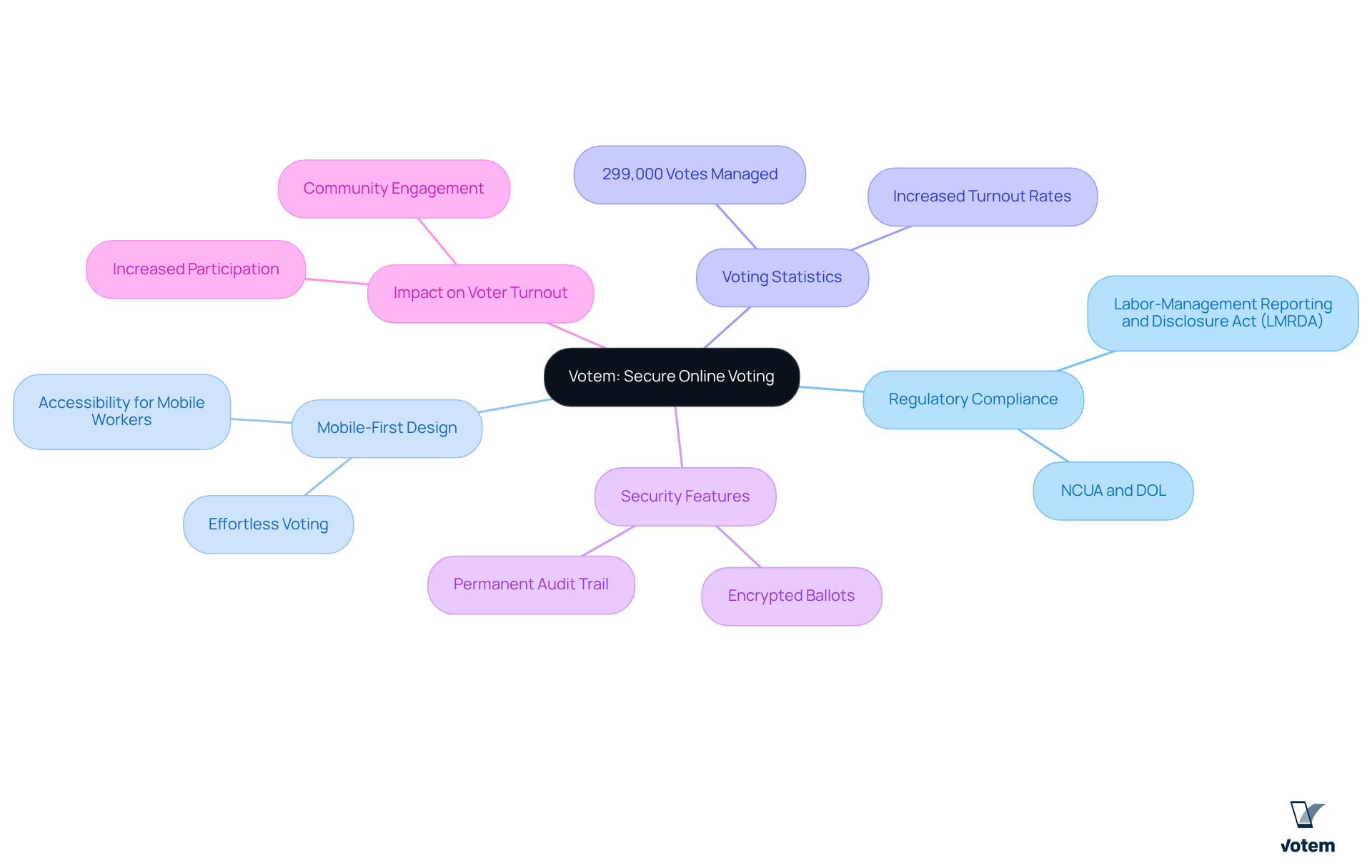
Define Membership Criteria: Establish Clear Participation Guidelines
Establishing membership standards is crucial for any organization. It determines who qualifies as a participant, the joining steps, and the responsibilities individuals must meet. Clear guidelines ensure that all eligible individuals can participate in decision-making processes, significantly enhancing democratic engagement and representation within the organization. Studies show that organizations with clear membership standards experience greater levels of participation, nurturing a sense of belonging and dedication among participants. Indeed, research indicates that 60 million workers would become part of a collective organization if possible, emphasizing the potential for greater involvement through clear membership definitions.
Furthermore, expert opinions suggest that clear participation guidelines empower organizations to mobilize their members effectively. This leads to increased turnout during elections and greater collective action. Moreover, utilizing technology, like the CastIron platform’s mobile-first design, can increase turnout by as much as 300% on launch day. This demonstrates how organizations can improve engagement. By prioritizing clarity in membership definitions, organizations can create an inclusive environment that values every voice, ultimately strengthening their influence and effectiveness in advocating for workers’ rights.
Conversely, challenges such as ‘right-to-work’ laws can complicate the establishment of these criteria. This makes it even more essential for labor organizations to clearly define their membership processes in line with the bylaws of association.
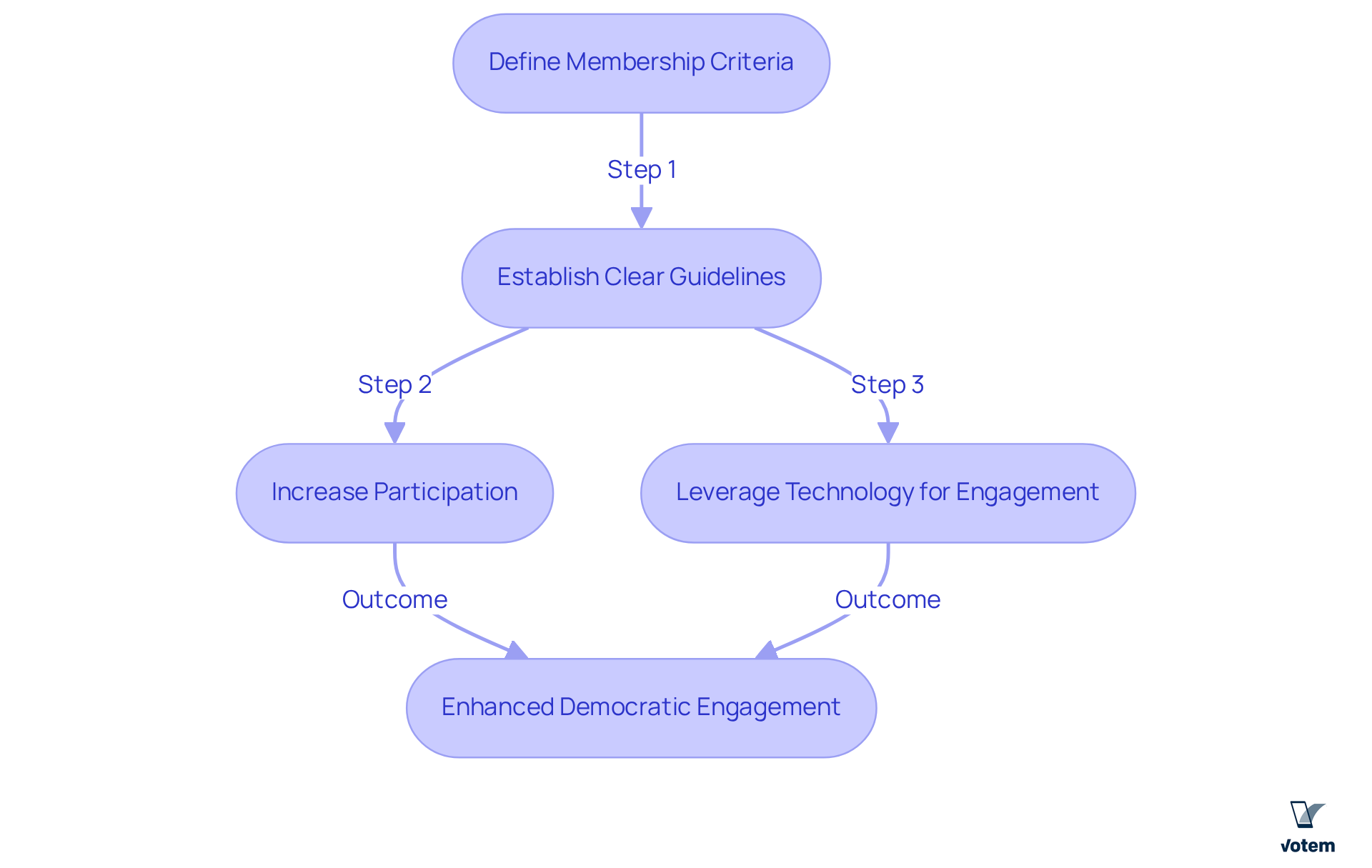
Detail Governance Structure: Ensure Effective Leadership and Decision-Making
A well-defined governance structure is crucial for effective leadership and decision-making within the organization. It outlines the hierarchy of leadership roles, including the executive board, committees, and general membership, ensuring that decisions are made efficiently and transparently. This clarity not only holds leaders responsible for their actions but also nurtures trust among the group. When individuals comprehend how choices are made and who holds accountability, they are more inclined to participate actively in collective activities.
Furthermore, effective governance frameworks highlight transparency and inclusivity, which are essential for fostering a robust, participatory community culture. By prioritizing a clear governance structure, organizations can enhance participant trust and encourage a collaborative environment that supports collective objectives. In addition, this structured approach can lead to improved engagement and a stronger commitment to shared goals among all members.
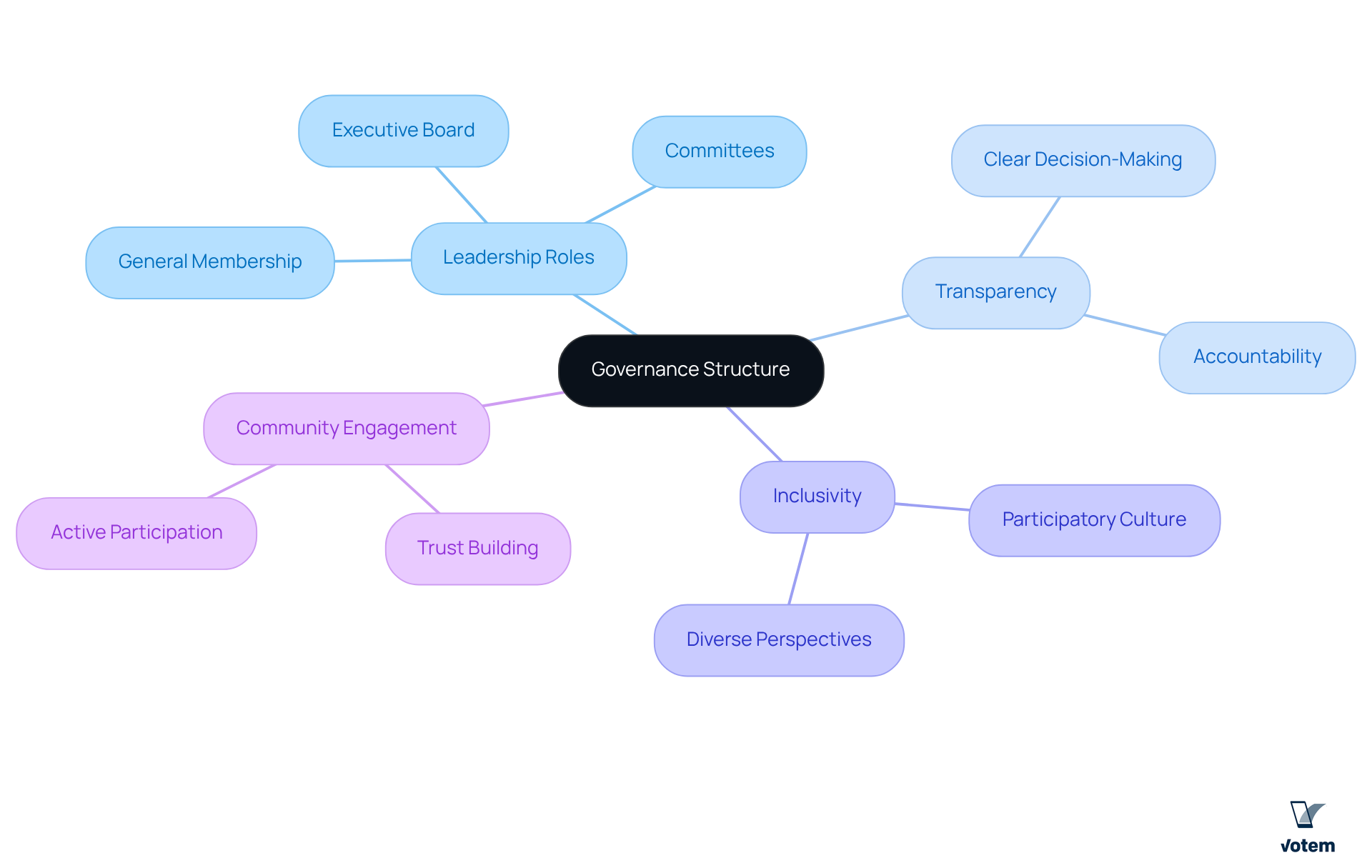
Clarify Roles of Committees: Enhance Operational Efficiency
Committees play a crucial role in enhancing an organization’s effectiveness, and defining clear roles and responsibilities is essential for boosting operational efficiency. By explicitly outlining each committee’s purpose, tasks, and reporting methods, associations can ensure that members focus on their objectives and make significant contributions to the organization’s overall aims. This clarity not only streamlines processes but also fosters accountability, enabling committees to work more cohesively. Successful organizations illustrate how clearly defined committee roles lead to improved decision-making and resource distribution, ultimately advancing the group’s mission.
For instance, the recent surge in labor election filings—evidenced by a remarkable 27% growth in petitions between fiscal years 2023 and 2024—demonstrates the positive outcomes of efficient committee frameworks. Furthermore, as Celine McNicholas highlights, “If the labor movement is to capitalize on the public’s strong backing for worker organizations and enhance membership rates, it requires not only increased organizing but also significant policy reform.” This statement underscores the necessity of defined roles within committees to effectively manage the challenges posed by deficiencies in U.S. labor legislation, ensuring that labor organizations can adapt and thrive in a dynamic environment.
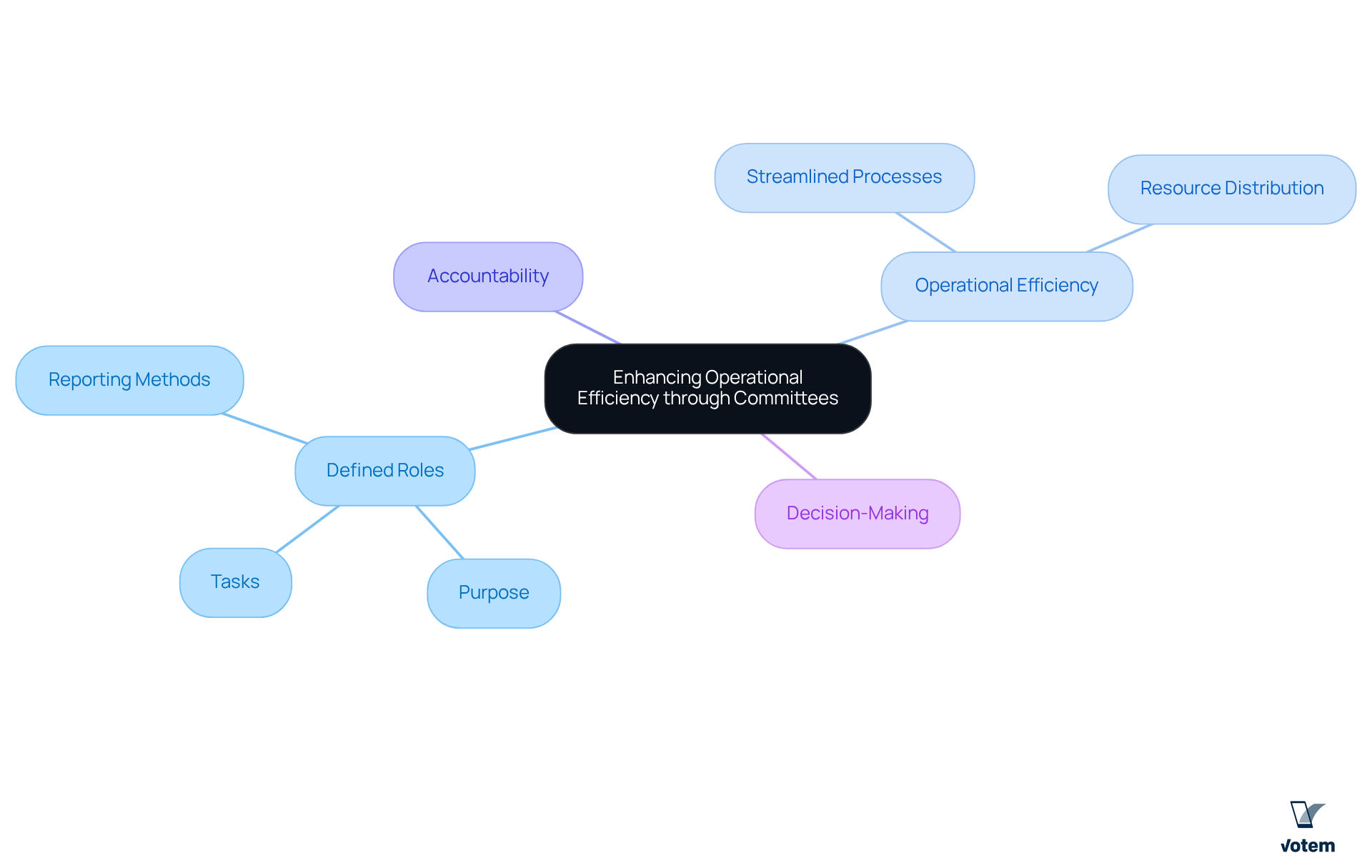
Establish Decision-Making Mechanisms: Navigate Complex Negotiations
Establishing clear decision-making mechanisms is essential for organizations, particularly during negotiations. This encompasses:
- Voting procedures
- Consensus-building strategies
- Guidelines for resolving disputes
By utilizing the adaptable online ballot system, organizations can enhance their voting methods. This ensures that all voices are acknowledged and that choices reflect the shared interests of the membership. Furthermore, Votem’s CastIron platform empowers organizations with innovative mobile voting solutions. These enhancements improve accessibility and security, ultimately leading to more successful negotiations and increased voter trust.
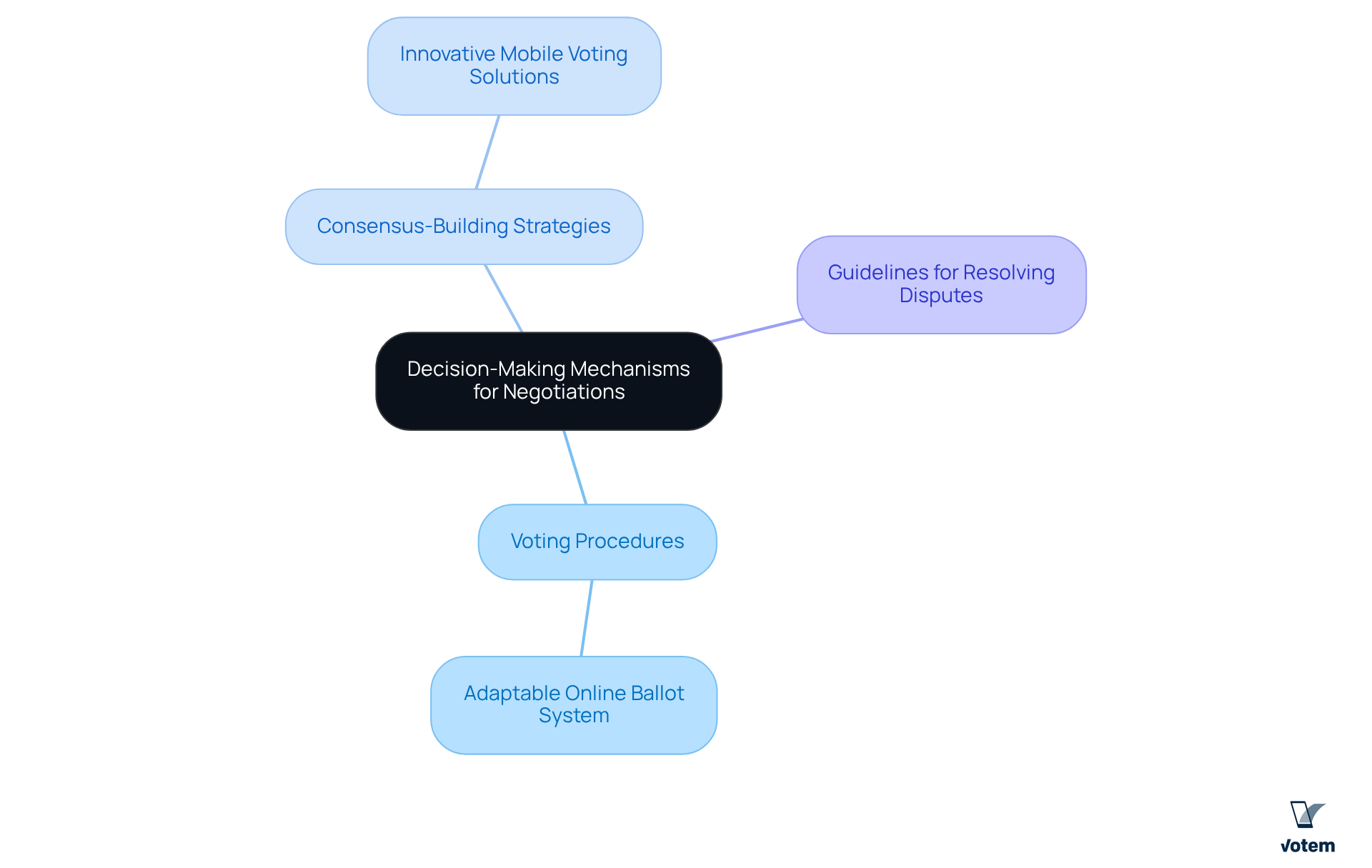
Detail Duties and Election of Officers: Maintain Transparency and Accountability
Clearly detailing the responsibilities of labor representatives and the election procedure is essential for promoting transparency and accountability within labor organizations. This involves outlining the specific responsibilities assigned to each officer, establishing term lengths, and defining the procedures for nominations and elections. By simplifying these procedures and ensuring they are approachable, organizations can foster trust among their constituents—a crucial factor for encouraging increased involvement in leadership positions.
Recent trends indicate that unions adopting clear election processes have experienced significant increases in member engagement. Secure online voting solutions, such as those offered by another provider, enhance both accessibility and security. The contemporary system has enabled improved access for all eligible voters, including military personnel and individuals with disabilities, greatly increasing participation. One testimonial highlights this success: “Votem successfully handled the receipt of 299,000 votes on behalf of the National Radio Hall of Fame, an increase over last year’s 126,000 votes received.” This not only boosts participation but also reinforces the belief that every vote is significant, ultimately fortifying the democratic foundation of the organization.
Addressing potential obstacles to voting, such as transportation difficulties and inaccessible polling places, is essential. Transparent election procedures can help alleviate these issues and ensure that all individuals can participate fully.
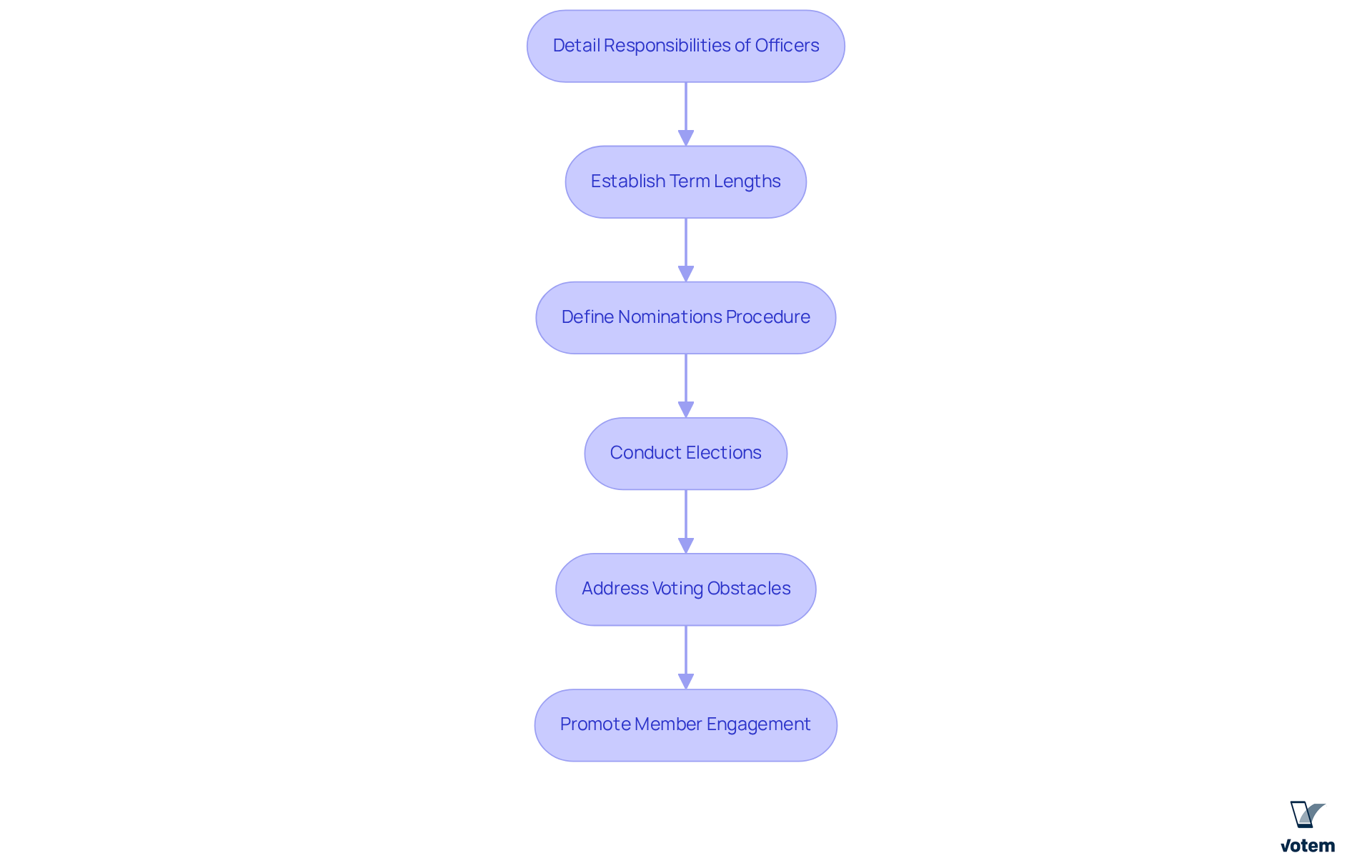
Set Meeting Schedules: Ensure Regular Communication
Establishing regular meeting times is vital for fostering effective communication within the organization. This entails defining clear frequencies for general meetings, committee gatherings, and special sessions. A consistent schedule not only keeps individuals informed about key issues but also actively encourages their involvement, thereby enhancing overall engagement.
By cultivating a sense of community, organizations can create an environment where individuals feel valued and connected. Furthermore, effective communication strategies—such as sharing agendas in advance and promoting open dialogue during meetings—serve to strengthen this connection, ensuring that all voices are acknowledged and respected.
As associations navigate the complexities of 2025, prioritizing these practices will be essential for maintaining robust participant engagement and support. Timely and proactive communication is crucial in preventing issues from escalating, underscoring the significance of these regular interactions.
As noted, “Trust is the cornerstone of any successful relationship, and this holds true for union-management interactions,” emphasizing the necessity for transparency and open dialogue.
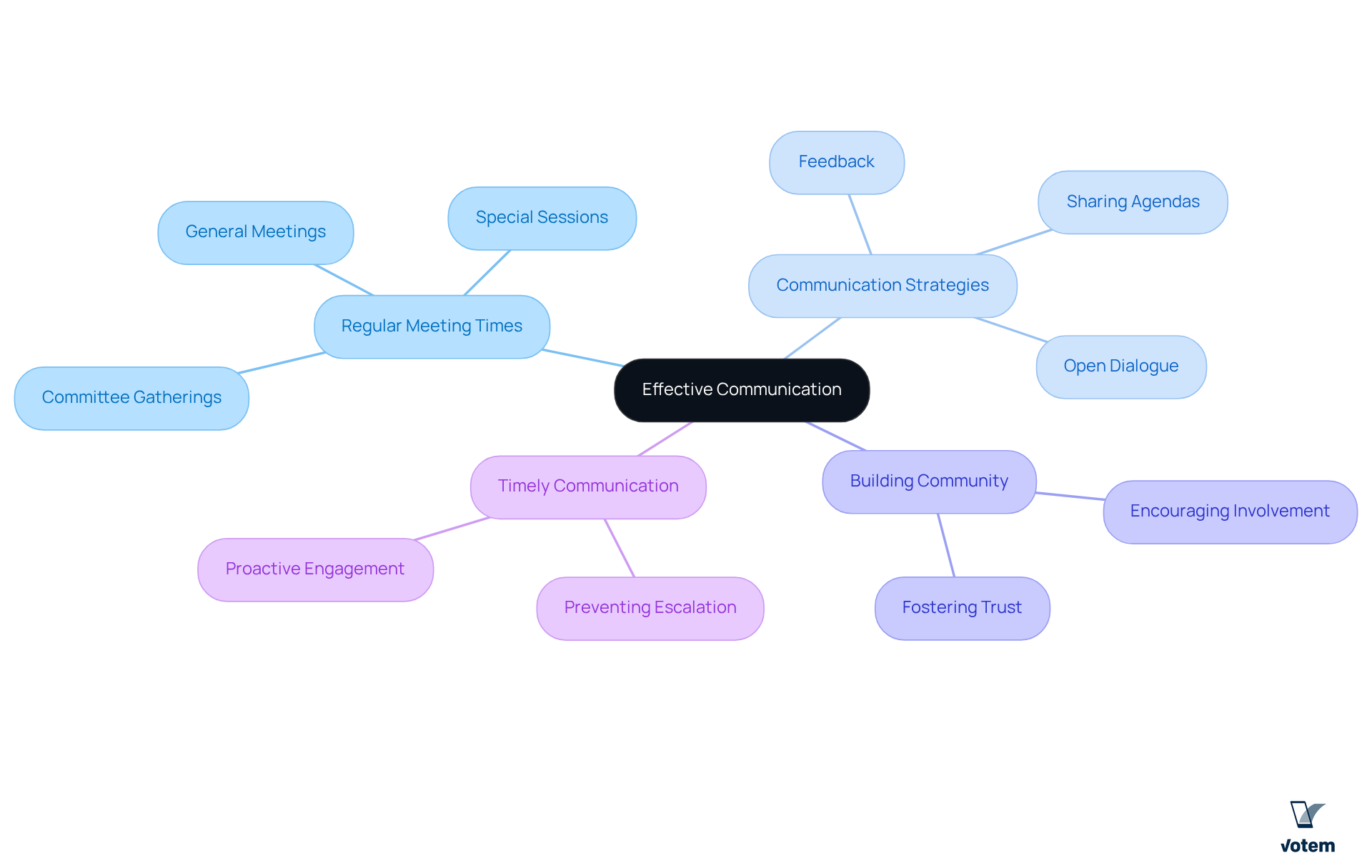
Create Framework for Amending Bylaws: Adapt to Changing Needs
Establishing a robust framework for modifying bylaws is essential for organizations aiming to effectively respond to the evolving needs of their constituents. This structure must clearly outline the procedures for proposing amendments, the required approvals, and the methods for communicating changes to members. By fostering flexibility in governance, organizations can adeptly navigate new challenges and seize opportunities, thereby ensuring their continued relevance and effectiveness in a dynamic environment.
For instance, regions with a higher density of labor organizations boast median household incomes significantly above those in areas with lower labor organization density, illustrating the economic benefits of flexible governance. As Heidi Shierholz noted, “When employees affiliate with organizations, their wages increase, and their working conditions enhance,” underlining the importance of accountable governance. Such adaptability not only enhances organizational resilience but also strengthens the association’s commitment to its constituents, ensuring that their voices are recognized and valued.
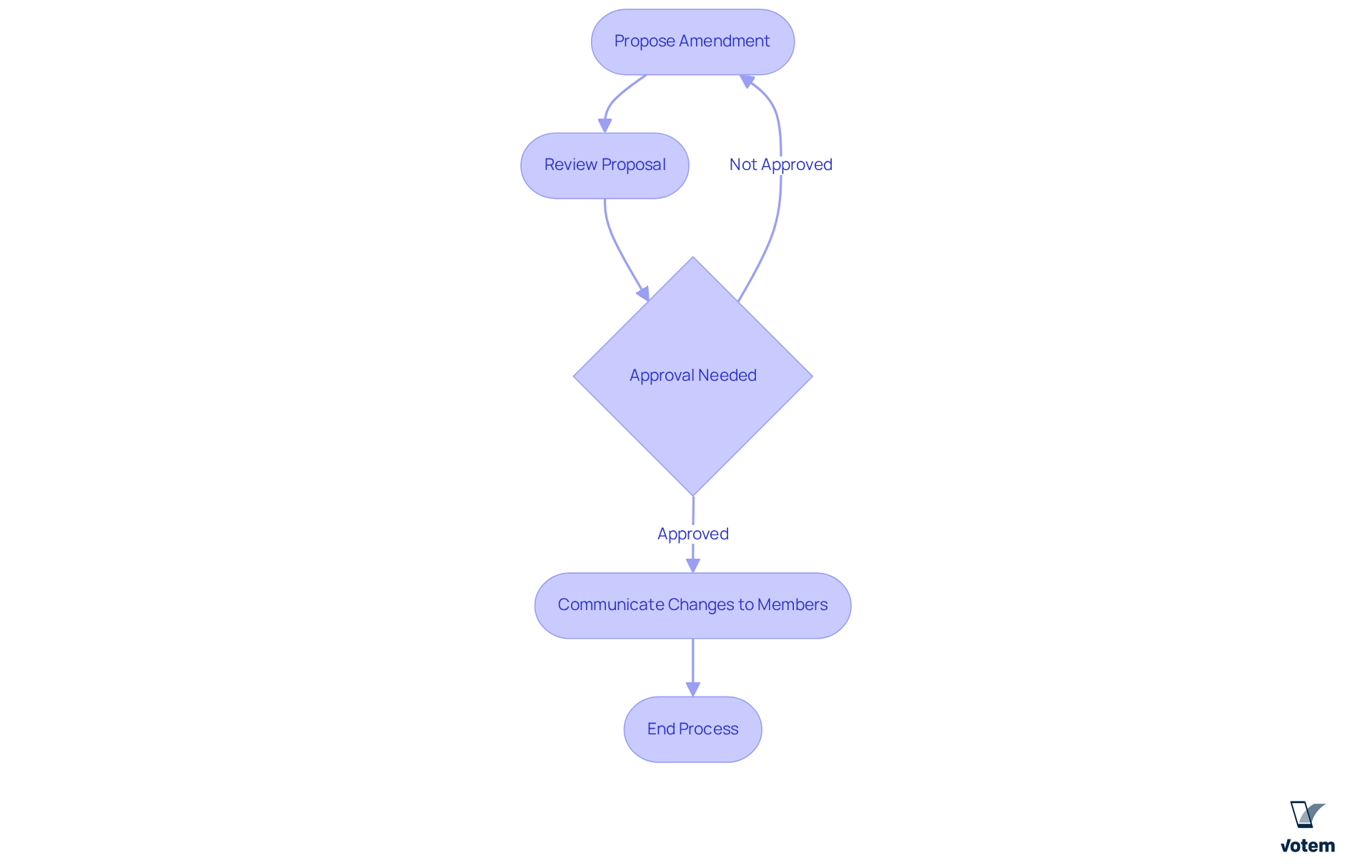
Establish Financial Management Protocols: Ensure Fiscal Responsibility
Establishing strong financial management protocols is crucial for upholding fiscal responsibility within organizations. This involves not only creating comprehensive budgets and closely monitoring expenditures but also ensuring transparency in financial reporting. By adopting sound financial practices, organizations can cultivate trust among their constituents, demonstrating accountability and integrity.
Furthermore, efficient resource distribution aids collective activities and initiatives, ultimately improving the organization’s capacity to serve its constituents and uphold its obligations. In 2023, 16.2 million workers were represented by an association, reflecting a growing demand for strong governance and fiscal responsibility.
As observed by Celine McNicholas, the Protecting the Right to Organize (PRO) Act seeks to enhance workers’ rights, emphasizing the importance of the bylaws of association in preserving financial integrity to effectively support their members.
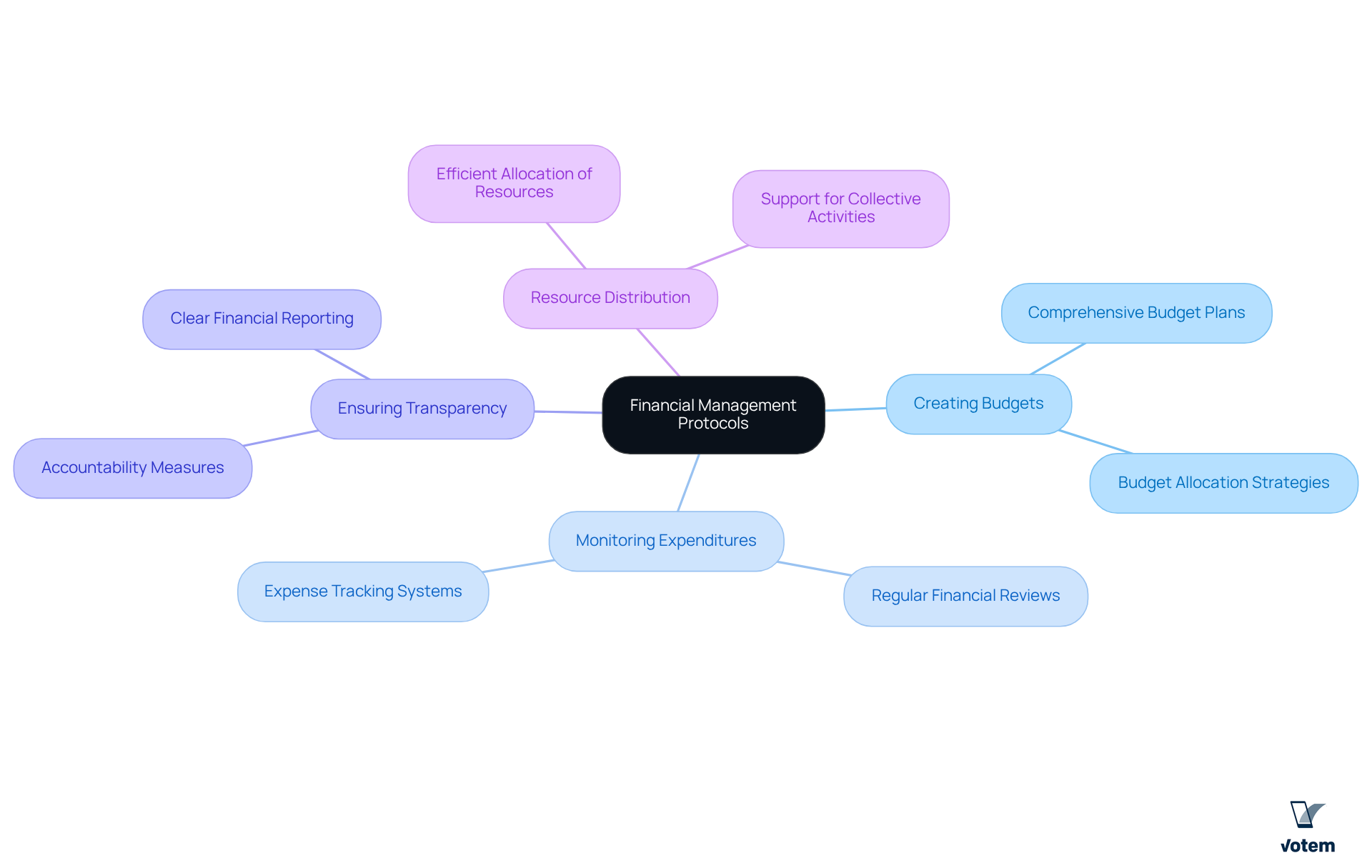
Lay Down Dissolution Procedures: Prepare for Organizational Changes
Establishing clear dissolution procedures is crucial for effective organizational governance. It is essential to define the specific circumstances that may lead to the organization’s dissolution, detail the procedural steps involved, and outline the management of assets. The dissolution procedure involves five key steps:
- Hold a vote with the board of directors to dissolve the organization, documented in official meeting minutes.
- Write and implement a formal ‘plan of dissolution’ that details asset distribution and liability management.
- Settle all liabilities, including future commitments and applicable taxes.
- Distribute remaining assets to another tax-exempt organization or the government.
- Notify federal and state agencies, including the IRS, of the dissolution.
By implementing transparent procedures, unions can keep individuals informed and prepared for potential changes, fostering a sense of security and stability within the organization. Furthermore, a well-organized dissolution process not only reduces confusion but also strengthens trust among participants, ensuring that their interests are protected throughout the transition. It is important to acknowledge that dissolving an organization can be difficult and emotional, whether voluntary or involuntary. This proactive approach is essential for maintaining member confidence and minimizing emotional distress during what can be a challenging time.
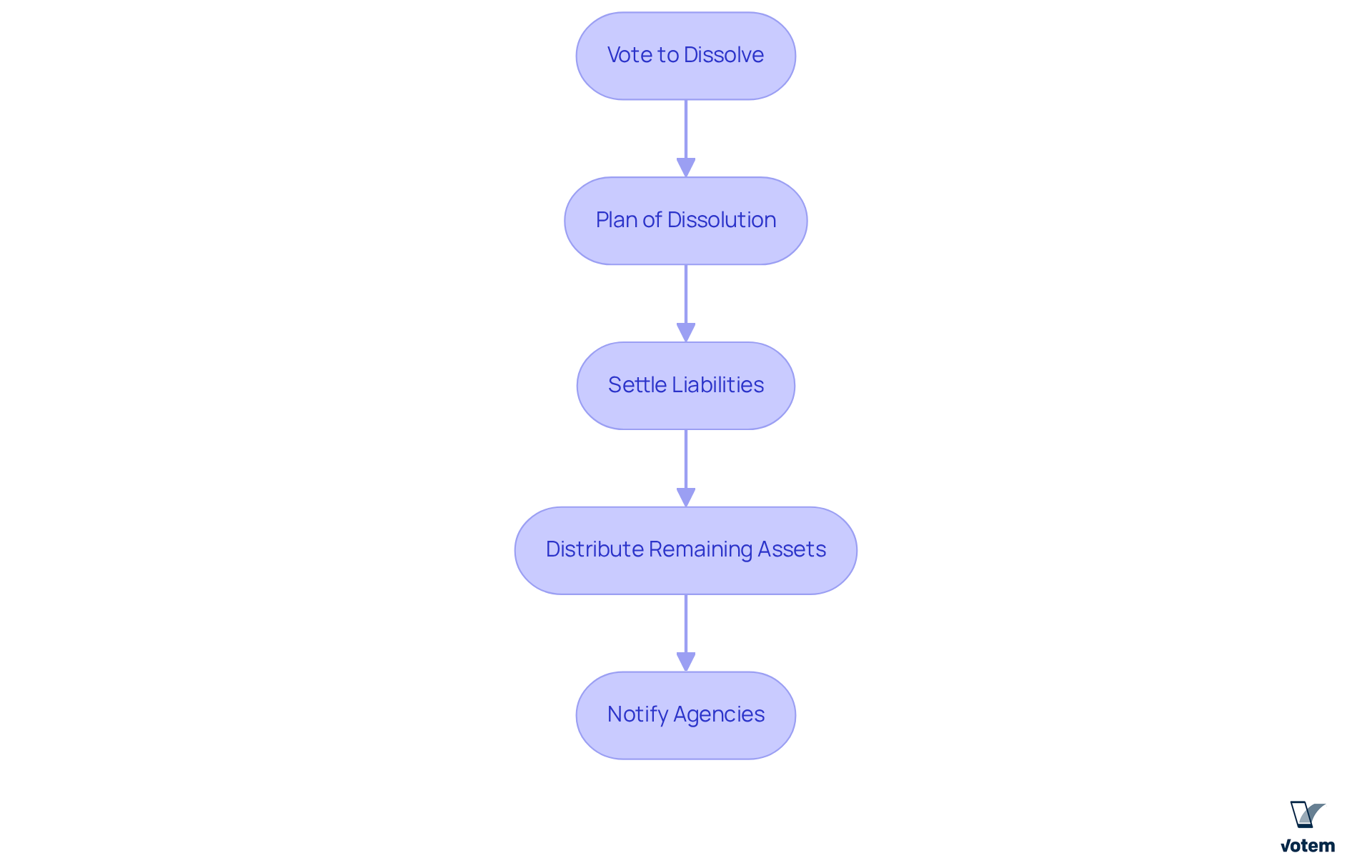
Conclusion
Establishing essential bylaws for union leadership is fundamental to fostering a successful and effective organization. These bylaws serve as the backbone for governance, ensuring clarity in roles, responsibilities, and processes that facilitate member engagement and trust. By implementing robust frameworks, unions can navigate complexities and adapt to the evolving needs of their constituents, ultimately enhancing their influence and effectiveness in advocating for workers’ rights.
Throughout the article, key points have been emphasized, including:
- The significance of secure online voting to boost participation
- The necessity of clear membership criteria to foster inclusivity
- The importance of a well-defined governance structure for accountability and transparency
Furthermore, insights on operational efficiency through clearly defined committee roles, effective decision-making mechanisms, and transparent election processes further highlight how structured approaches can lead to increased member engagement and trust.
In reflection, the importance of these bylaws cannot be overstated. They not only provide a roadmap for organizational success but also empower unions to adapt and thrive amidst challenges. By prioritizing clear communication, fiscal responsibility, and proactive governance, labor organizations can ensure they remain relevant and responsive to their members’ needs. This commitment to strong bylaws and effective leadership will ultimately enhance the collective strength of unions, driving positive change for workers everywhere.
Frequently Asked Questions
What is Votem, and how does it benefit union elections?
Votem is a secure online voting platform provided by CastIron, specifically designed for labor organizations. It ensures compliance with regulations like NCUA and DOL, enhancing voter trust and participation. Its mobile-first design allows for effortless voting, significantly improving turnout in organizational elections.
Can you provide an example of Votem’s effectiveness?
Yes, Votem successfully managed 299,000 votes for the National Radio Hall of Fame, showing a notable increase from the previous year and demonstrating its capability to handle large-scale voting efficiently.
What security features does Votem offer?
Votem offers features such as encrypted ballots and a permanent audit trail, ensuring that each vote is counted accurately and transparently, which fosters trust among workers in the electoral system.
How does clear membership criteria impact organizational participation?
Clear membership standards determine who qualifies as a participant and the steps for joining, enhancing democratic engagement and representation. Organizations with clear criteria experience greater levels of participation and a sense of belonging among members.
What is the potential impact of technology on membership engagement?
Utilizing technology, such as CastIron’s mobile-first design, can increase turnout by as much as 300% on launch day, demonstrating how organizations can improve engagement and mobilize their members effectively.
What challenges do labor organizations face regarding membership criteria?
Challenges like ‘right-to-work’ laws can complicate the establishment of membership criteria, making it essential for labor organizations to clearly define their membership processes in accordance with their bylaws.
Why is a well-defined governance structure important?
A well-defined governance structure is crucial for effective leadership and decision-making, outlining the hierarchy of roles and ensuring efficient and transparent decisions. This clarity fosters trust and encourages active participation among members.
How does effective governance contribute to organizational culture?
Effective governance frameworks emphasize transparency and inclusivity, fostering a participatory community culture. By prioritizing a clear governance structure, organizations can enhance participant trust and commitment to shared goals.
List of Sources
- Votem: Secure Online Voting for Union Elections
- Online balloting moves closer for unions – TUC Digital Lab (https://digital.tuc.org.uk/online-balloting-moves-closer-for-unions)
- Jesuit Resource – Election Day Quotes (https://xavier.edu/jesuitresource/online-resources/quote-archive1/election-dayvoting)
- 10 Ways to Increase Voter Turnout in the United States | Online Voting with Votem® (https://votem.com/10-ways-to-increase-voter-turnout-in-the-united-states)
- Electing Union Officers Using Remote Electronic Voting Systems (https://dol.gov/agencies/olms/compliance-assistance/tips/remote-electronic-voting-systems)
- Define Membership Criteria: Establish Clear Participation Guidelines
- Majorities of adults see decline of union membership as bad for the U.S. and working people (https://pewresearch.org/short-reads/2025/08/27/majorities-of-adults-see-decline-of-union-membership-as-bad-for-the-us-and-working-people)
- 16 million workers were unionized in 2024: Millions more want to join unions but couldn’t (https://epi.org/publication/millions-of-workers-millions-of-workers-want-to-join-unions-but-couldnt)
- 7 Strategies to Engage Union Voters Effectively | Online Voting with Votem® (https://votem.com/7-strategies-to-engage-union-voters-effectively)
- Union Members Summary
- 2024 A01 Results (https://bls.gov/news.release/union2.nr0.htm)
- Detail Governance Structure: Ensure Effective Leadership and Decision-Making
- The TCM Group | Royal Mail Case Study (https://thetcmgroup.com/case_studies/royal-mail-case-study)
- 50 Powerful Leadership Quotes to Inspire Your Organization (https://qualtrics.com/articles/employee-experience/50-powerful-leadership-quotes)
- Workers want unions, but the latest data point to obstacles in their path: Private-sector unionization rose by more than a quarter million in 2023, while unionization in state and local governments fell (https://epi.org/publication/union-membership-data)
- A Brief Examination of Union Membership Data (https://congress.gov/crs-product/R47596)
- Clarify Roles of Committees: Enhance Operational Efficiency
- 16 million workers were unionized in 2024: Millions more want to join unions but couldn’t (https://epi.org/publication/millions-of-workers-millions-of-workers-want-to-join-unions-but-couldnt)
- Labor unions mobilize to challenge advance of algorithms in workplaces (https://washingtonpost.com/business/2025/08/12/unions-ai-regulation-workplaces)
- (PDF) The role of social dialogue in skills initiatives: A case study approach (https://researchgate.net/publication/228366270_The_role_of_social_dialogue_in_skills_initiatives_A_case_study_approach)
- A Brief Examination of Union Membership Data (https://congress.gov/crs-product/R47596)
- Union Members Summary
- 2024 A01 Results (https://bls.gov/news.release/union2.nr0.htm)
- Establish Decision-Making Mechanisms: Navigate Complex Negotiations
- Top 5 Negotiation Quotes | Scotwork Global (https://scotwork.com/negotiation-insights/top-5-negotiation-quotes)
- Best Decision Quotes – 70 Inspirational Decision-Making Quotes (https://1000minds.com/decision-making/decision-quotes)
- Collective Bargaining at NBA: Who scores the basket? | Human Resource Management Case Study (https://ibscdc.org/Case_Studies/HRM/HRM0059.htm)
- Negotiation Quotes — 25 Legendary Quotes Full of Wisdom (https://procurementtactics.com/negotiation-quotes)
- Workers want unions, but the latest data point to obstacles in their path: Private-sector unionization rose by more than a quarter million in 2023, while unionization in state and local governments fell (https://epi.org/publication/union-membership-data)
- Detail Duties and Election of Officers: Maintain Transparency and Accountability
- Workers want unions, but the latest data point to obstacles in their path: Private-sector unionization rose by more than a quarter million in 2023, while unionization in state and local governments fell (https://epi.org/publication/union-membership-data)
- 7 Strategies to Engage Union Voters Effectively | Online Voting with Votem® (https://votem.com/7-strategies-to-engage-union-voters-effectively)
- Set Meeting Schedules: Ensure Regular Communication
- The TCM Group | Royal Mail Case Study (https://thetcmgroup.com/case_studies/royal-mail-case-study)
- Best Practices for Effective Union Communication | EOXS (https://eoxs.com/new_blog/best-practices-for-effective-union-communication)
- Uniting Unions in Support of Employee Engagement (https://talentmap.com/uniting-organizations-and-unions-in-support-of-employee-engagement)
- Negotiation Quotes — 25 Legendary Quotes Full of Wisdom (https://procurementtactics.com/negotiation-quotes)
- International Trade Union and EWC Communication | York Associates (https://york-associates.co.uk/case_study/international-trade-union-and-ewc-communication)
- Create Framework for Amending Bylaws: Adapt to Changing Needs
- Unions, Worker Voice, and Management Practices: Implications for a High-Productivity, High-Wage Economy (https://rsfjournal.org/content/5/5/88)
- Unions aren’t just good for workers—they also benefit communities and democracy (https://epi.org/publication/unions-arent-just-good-for-workers-they-also-benefit-communities-and-democracy)
- Workers want unions, but the latest data point to obstacles in their path: Private-sector unionization rose by more than a quarter million in 2023, while unionization in state and local governments fell (https://epi.org/publication/union-membership-data)
- Establish Financial Management Protocols: Ensure Fiscal Responsibility
- Quotes About Fiscal Responsibility and Integrity – Values of the Wise (https://valuesofthewise.com/quotes-about-fiscal-responsibility)
- 86+ Surprising Fiscal Responsibility Quotes (https://quotlr.com/quotes-about-fiscal-responsibility)
- Workers want unions, but the latest data point to obstacles in their path: Private-sector unionization rose by more than a quarter million in 2023, while unionization in state and local governments fell (https://epi.org/publication/union-membership-data)
- A Brief Examination of Union Membership Data (https://congress.gov/crs-product/R47596)
- Lay Down Dissolution Procedures: Prepare for Organizational Changes
- Closing a Nonprofit Organization | Carr, Riggs & Ingram (https://criadv.com/insight/closing-nonprofit-organization)

